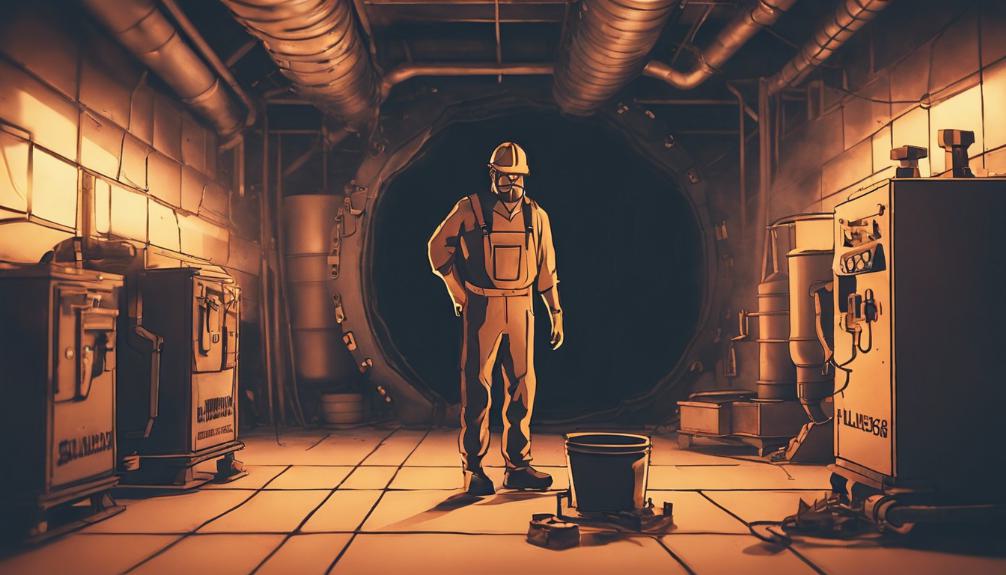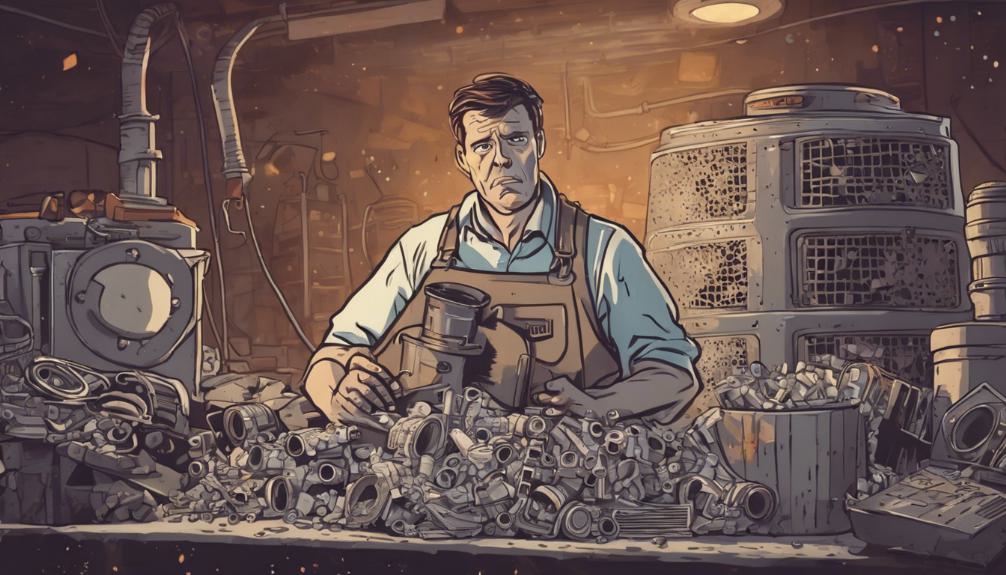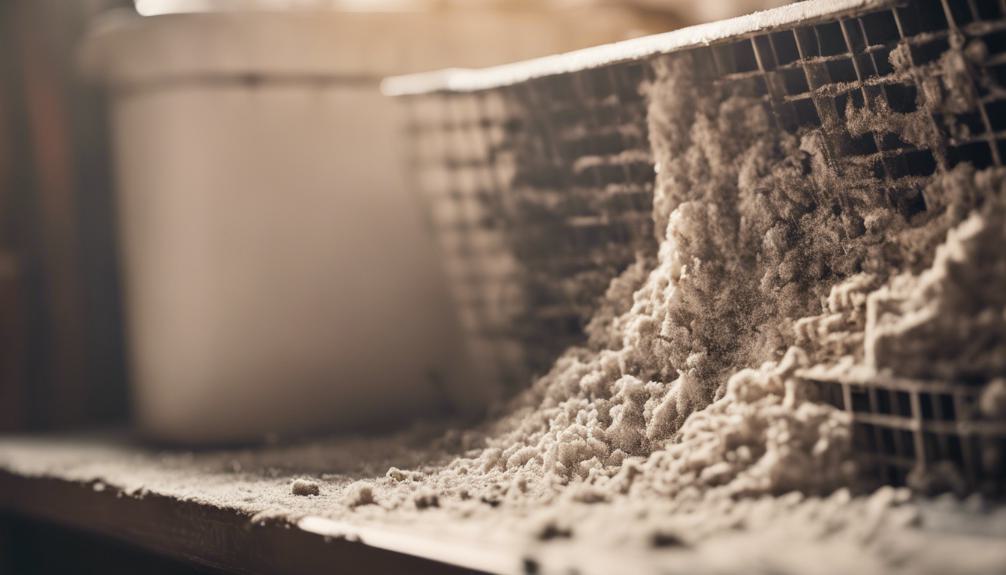Breathe easier and save money by mastering furnace filter replacement. Neglecting to replace your filter can hike energy bills by up to 15% and worsen indoor air quality, exacerbating respiratory issues like asthma.
Regular replacement improves indoor air quality, reduces energy consumption, and saves you money.
Step-by-Step Guide:
- Gather tools: new filter, screwdriver, and a vacuum cleaner.
- Turn off the furnace power.
- Open the filter compartment.
- Remove the old filter.
- Clean the compartment.
- Install the new filter.
- Restore power and test the furnace.
Troubleshoot common issues: wrong filter size, dirty filters, and incorrect installation.
Key Takeaways
• Neglecting to replace furnace filters increases energy bills, worsens indoor air quality, and exacerbates respiratory issues like asthma.
• Filter replacement frequency depends on filter type, quality, and seasonal usage, with most filters needing replacement every 1-3 months.
• Gather essential tools, review the filter warranty, and ensure a smooth replacement process by checking filter accessibility and housing specifications.
• Turn off furnace power, locate and open the filter housing, dispose of the old filter, and install the new one with proper alignment and airflow direction.
• Post-installation, verify furnace performance, check for faulty sensors, inspect ducts and vents, and ensure unobstructed airflow to prevent further complications.
Why Filter Replacement Matters

Neglecting to replace your furnace filter leads to serious consequences. Airborne pollutants and debris circulate freely, affecting indoor air quality and energy consumption.
A dirty filter makes your furnace work harder, increasing energy bills by up to 15%. This is because the furnace has to expend more energy to push air through the clogged filter, reducing system efficiency.
A dirty filter compromises indoor air quality, allowing pollutants and allergens to circulate. This exacerbates respiratory issues like asthma and allergies, making your home unhealthy.
Regularly replacing your furnace filter improves indoor air quality, reduces energy consumption, and saves you money on energy bills. It's a critical maintenance task that impacts your health, comfort, and wallet.
How Often to Replace Filters
When it comes to replacing your furnace filter, you're probably wondering how often to do so.
The answer depends on several factors, including the type of filter you're using, the time of year, and the manufacturer's recommendations.
You'll need to take these factors into account to determine the best replacement schedule for your specific situation.
Filter Type Matters
Filter Type Affects Replacement Frequency
Furnace filter type determines its efficiency, effectiveness, and replacement frequency. Basic fiberglass filters, the most common type, need replacement every 1-3 months.
Higher-quality pleated filters last up to 6 months, while high-efficiency filters can go up to a year without replacement.
Filter Quality Impacts Replacement Frequency
Filter quality, measured by its MERV rating, affects replacement frequency. High-quality filters capture smaller particles, providing better air purification, but may need more frequent replacement.
Lower-quality filters capture fewer particles, lasting longer due to reduced filtering capacity. Understanding filter type and quality determines the best replacement frequency.
MERV Rating and Replacement Frequency
- Basic fiberglass filters: 1-3 months
- Higher-quality pleated filters: up to 6 months
- High-efficiency filters: up to 1 year
Seasonal Schedules
Seasonal Filter Replacement Schedules:
Winter: Replace furnace filters every 1-2 months. Continuous furnace use during winter increases filter workload, requiring frequent replacements to maintain air quality and prevent dust buildup.
Spring: Replace filters every 2-3 months, aligning with Spring cleaning routines. This ensures fresh, clean air when windows are opened to let in fresh air.
Summer and Fall: Filter replacement schedules may vary depending on individual HVAC system usage and environmental factors. Monitor filter performance and adjust replacement schedules accordingly.
Manufacturer's Guidelines
Furnace Filter Replacement Frequency
Manufacturers recommend replacing furnace filters every 1-3 months, depending on factors such as filter type, usage, and environmental conditions.
Factors Considered by Manufacturers:
- Filter material and quality affect replacement schedules.
- System airflow and capacity influence filter lifespan.
- Environmental factors like dust, pet dander, and humidity impact filter effectiveness.
- Improper filter maintenance can void warranties.
- Manufacturers must adhere to industry standards and regulations.
Preparing for Filter Replacement

Before you start replacing your furnace filter, make sure you're prepared by gathering essential tools like a new filter, a screwdriver, and a vacuum cleaner.
Next, check the filter's accessibility, taking note of any obstacles or complexities that might affect the replacement process.
Gather Essential Tools
Gather necessary tools and equipment, including a replacement filter, screwdriver, pliers, and vacuum cleaner, for a smooth filter replacement process.
Having all required tools saves time and frustration. A well-organized toolbox prevents wasting time searching for misplaced tools.
Review your filter warranty before starting the replacement process. Check its validity and required maintenance tasks to keep it in effect. Proper filter maintenance extends its lifespan and ensures efficient furnace operation.
Essential tools include:
- replacement filter matching furnace specifications
- screwdriver to remove filter housing screws
- pliers to grip and remove stubborn screws or clips
With these tools and understanding of filter warranty, you're ready for the next step.
Check Filter Accessibility
Locate Filter Housing
The filter housing is typically located in the return air duct, but its exact location may vary depending on your furnace's design and installation. Check your furnace manual if you're unsure.
Determine How to Open the Filter Housing
Inspect the filter housing to determine how it opens. Some filters slide out, while others may require removing screws or clips. Take note of any screws, clips, or latches that hold the housing in place. You may need to remove these to access the filter.
Plan Your Approach
Consider the filter location when planning your approach. If the filter is located in a tight space, you may need to use a flashlight or mirror to see inside the housing. Take your time and work carefully to avoid damaging the housing or surrounding components.
Access the Filter
With the filter housing open, you're one step closer to replacing your furnace filter.
Step-by-Step Filter Replacement
Replace the old filter with a new one by turning off the power to the furnace at the circuit breaker or fuse box to ensure safety.
Locate the filter housing, usually in a return air duct or near the furnace. Open the housing by removing screws or clips.
Pull out the old filter, noting the airflow direction arrows for proper installation of the new filter. Dispose of the old filter responsibly, as it may contain hazardous materials.
Remove debris or dust from the filter housing and surrounding area for a clean installation.
Install the new filter, ensuring it's properly seated and airflow direction arrows are aligned.
Troubleshooting Common Issues

Verify Furnace Performance
After installing a new filter, check the furnace's performance to ensure it's working efficiently. Faulty installation or other issues can lead to reduced airflow, increased energy bills, or system failure. Confirm the furnace produces the correct temperature and consistent airflow. If you notice issues, troubleshoot promptly.
Faulty Sensors
Faulty sensors can cause the furnace to malfunction. Check sensors for dust or debris accumulation and clean them gently if necessary.
Airflow Restrictions
Inspect ducts and vents for blockages, kinks, or damage. Ensure all vents are open and unobstructed to maintain efficient airflow. Blockages put excessive strain on the furnace, leading to premature wear and tear.
Maximizing Filter Efficiency
Maximize Filter Efficiency
Align Filter Correctly
Incorrect filter orientation can reduce efficiency by up to 50%. Ensure the filter is aligned with the furnace's airflow direction to guarantee even airflow pressure distribution.
Regular Filter Cleaning
Clean the filter every 1-3 months to remove dirt and debris that can reduce airflow and strain the furnace. Use a soft brush or vacuum cleaner to gently remove dust and dirt.
Proper Filter Installation
Install the filter correctly, ensuring airflow arrows point in the correct direction. This ensures the filter works efficiently and effectively.
Monitor Airflow Pressure
Regularly inspect ductwork to ensure there are no blockages or leaks. High airflow pressure can cause the filter to work harder, reducing its efficiency.
Frequently Asked Questions
Can I Clean and Reuse My Furnace Filter Instead of Replacing It?
You can try cleaning your furnace filter, but it's not recommended as a long-term solution. Proper filter maintenance is key to extending filter longevity, but cleaning may not restore its original efficiency, and replacement is often still necessary.
What Happens if I Install My Filter Backwards by Mistake?
If you install your filter backwards by mistake, you'll restrict airflow, reducing your furnace's efficiency and potentially causing filter damage; this mistake can lead to premature wear on your heating system's components.
Are All Furnace Filters of the Same Quality and Performance?
You'll find that not all furnace filters are created equal, as differences in filter materials and manufacturer variance have a notable impact on performance, with some offering superior airflow, filtration, and durability than others.
Can I Upgrade to a Higher MERV Rating Without Modifications?
You can upgrade to a higher MERV rating, but make sure filter compatibility with your system's capacity. If not, you'll face reduced airflow, increased energy bills, and potential system damage, so assess your system's capacity before making the switch.
Will a Dirty Filter Increase My Energy Bills and Consumption?
You'll notice a hike in energy bills and consumption when you neglect filter maintenance, as a dirty filter reduces airflow, forcing your system to work harder and decreasing energy efficiency, ultimately increasing your costs.
Conclusion
You've successfully replaced your furnace filter and taken an important step in maintaining a healthy, efficient, and safe heating system. Remember to check and replace your filter regularly to prevent damage, reduce energy bills, and breathe easier.
By following these steps, you'll guarantee your furnace runs smoothly, and you'll enjoy a warm and cozy home all winter long.
